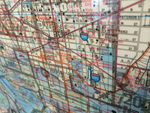
Photo credit: Manfred Heyde via Wikimedia Commons
As the co-publisher (with my daughter) of a series of printed guidebooks, it would not be appropriate for me to use this blog to publicize our own particular books. But when it comes to the entire guidebook industry, some comments might be in order.
In the six years prior to 2014, the travel guidebook industry was in serious trouble. For each of the six years starting 2008, the public purchased a smaller number of print-on-paper guidebooks. Various experts pointed, for an explanation, to the increased popularity of electronic websites dealing with travel, and especially to those internet services that collected the reviews and hotel comments by members of the traveling public. Rather than rely on the guidebook recommendations of skilled local journalists as to where they should stay, eat and play, large numbers of Americans turned instead to the collected raves and critiques of travelers like themselves.
All told, the purchase of printed guidebooks to some destinations fell by as much as 40% in that period. Some companies left the guidebook industry altogether.
But to the relief of most publishers, the ecstatic joy of a few, the decline has apparently been halted, and the sale of printed guidebooks is again on the rise. In 2014, the sale of printed travel guidebooks was up by a small degree from the preceding year. In 2015 it rose again, by a slightly larger percentage. A study by the acknowledged expert in travel guide sales, Stephen Mesquita, apparently indicated that a large number of Americans were dissatisfied with the electronic sources of travel information, and had returned to the professional guidebook. Americans were showing an increasing comfort in bringing a printed guidebook by an experienced journalist, along with them on both their domestic and international trips.
For one thing, the sources of electronic travel information had grown so massive that they caused confusion and puzzlement among travelers. For another thing, the amateur and often biased nature of the non-journalists writing electronic recommendations was becoming so evident as to cause the traveler to doubt the usefulness of them.
Only in one smaller segment of printed travel information--maps--did a decline in sales continue through 2014 (though it has levelled off in 2015 and may again be on the rise). This was caused, of course, by the increasing public reliance on GPS systems for determining their whereabouts and directions. But the printed guidebook continued--and still continues, apparently--to grow more prominently in sales.
In terms of the most popular guidebook destinations purchased by the American pubic, Italy (according to Mr. Mesquita) is the leader, followed by Paris and New York City. After those, come Ireland, London, Spain and Rome (in that order). But once the guidebooks dealing with European destinations (and New York City) are accounted for, Costa Rica, Hawaii, and the U.S. National Parks come next, and their number includes Germany. As you will see, most Americans purchase guidebooks dealing with European nations, though Japan and Iceland come next. But if I were asked to guess about 2016 sales (not yet tabulated by Mr. Mesquita), I'd assume that Paris would drop way down (tourism to Paris has been badly affected by the terrorism there several months ago), while Japan and Iceland would move way up. The strengthening of the dollar against the Japanese yen has greatly increased travel to Japan, and Iceland--as noted in earlier columns of mine--has spurted upwards in popularity for reasons harder to discern.
So there you have a brief insight into the way that most Americans now plan their trips at home and abroad. Though electronic apps and the like remain well-used, they still compete with those increasingly-popular guidebooks that you read on printed pages.





